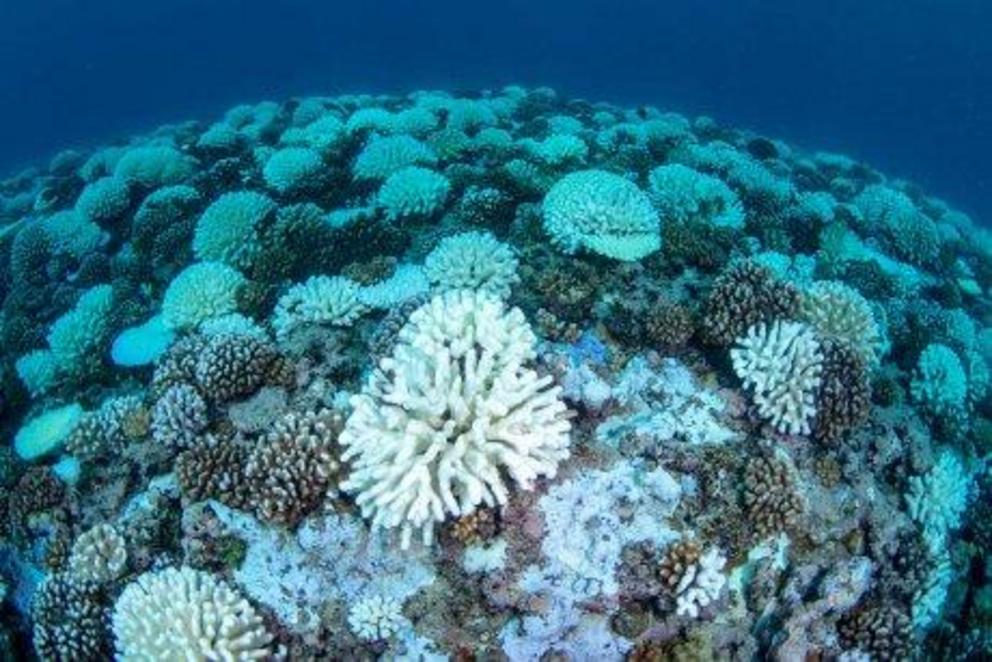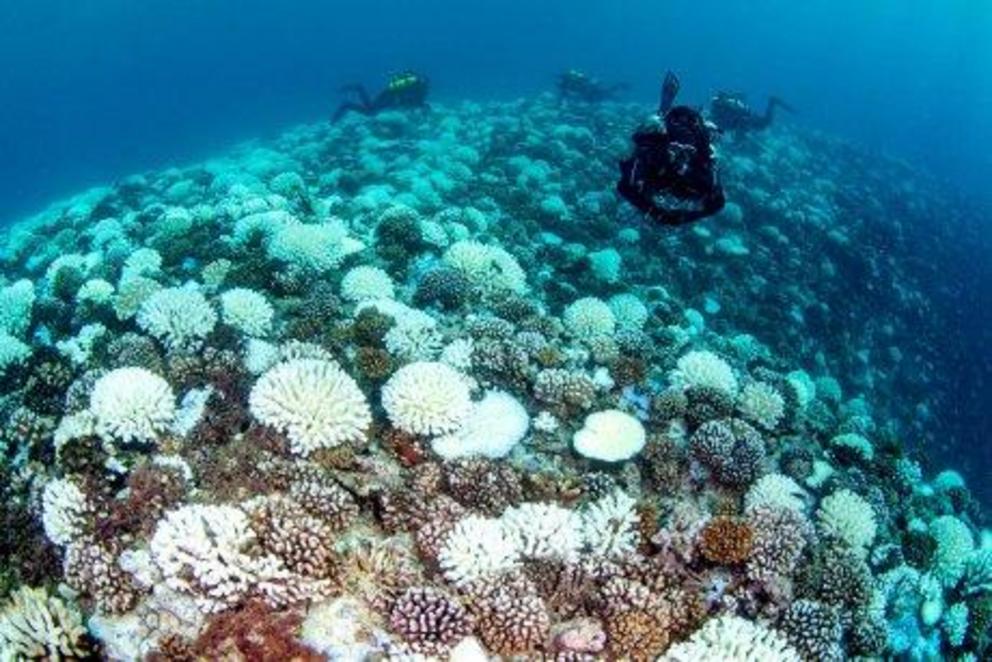Coral bleaching event underway in French Polynesia despite no El Nino
Coral bleaching happens when high water temperatures cause coral to expel its symbiotic algae.
Widespread coral bleaching has been reported in the French Polynesian islands of Tahiti and Moorea, even though there was no El Nino event this year.
Key points:
- More than 50 per cent of coral reefs around Tahiti and Moorea have been bleached
- Bleached corals have been observed as deep as 100 metres
- Scientists are concerned the lack of climate action will spell the end of the world's reefs
The reefs are among the most regularly bleached in the world, thanks to their position in the path of warm waters that spread west from South America during El Nino years.
This year, however, without the presence of an El Nino and the warmer water it brings, the reefs should have been spared.
But in the last few days, it's been estimated that 50 to 60 per cent of corals on reefs around Tahiti and Moorea have been bleached, according to marine biologist Luiz Rocha from the Californian Academy of Sciences.
"I've seen the reports of the Great Barrier Reef bleaching, but this is the first time I've seen [bleaching] myself, and it hits you a lot harder," Dr Rocha said.
"We have seen bleaching all the way down to 100 metres. But it's worst on the shallow, sheltered reefs."
Coral bleaching occurs when high water temperatures cause the coral to expel its symbiotic algae, revealing the white skeleton beneath.

Other research groups in the region have similarly reported bleaching on both sides of Tahiti, as water temperatures remain unusually high for this time of year.
"It's seems to be only the southern portion of French Polynesia that's bleaching, but definitely Tahiti and Moorea are severely bleached," Dr Rocha said.
"This is not a localised thing, it seems to be widespread."
In March, when the region's waters remained unusually warm, the US National Oceanic and Atmospheric Administration issued a bleaching warning.
But Dr Rocha said he did not expect the magnitude of bleaching that he'd seen.
"I was overwhelmed by sadness because I saw these reefs looking really healthy just two months ago."
Uncertain whether bleached corals will recover
If the water temperature drops in the next week or so, the bleached corals may survive and regain their symbiotic algae. But scientists on the islands haven't seen a drop in temperature yet.
"Already about half of the bleached corals we've seen are dead," Dr Rocha said.
"But we won't know for certain for a few weeks."
The sight of the bleaching was shocking to coral microbiologist Andrew Thurber from Oregan State University who also recently conducted surveys in Moorea.
"When I first got in the water I was completely disoriented. It was a carpet of white," Dr Thurber said.
"In our initial surveys we found over 90 per cent of the dominant coral species on the front reef were at least partially if not entirely bleached," he said.
"The reef there is currently on a knife edge, and we won't know if it recovers for some time.
"This bleaching was indiscriminate and if anything, worse at the normally healthy reefs."
If there is enough time for recovery between bleaching events — which increasingly there isn't — the corals that bounce back will be weedier, more resilient species, according to coral reef scientist Terry Hughes from the ARC Centre of Excellence for Coral Reef Studies.
"We've seen in the Great Barrier Reef that we have winners and losers in terms of susceptibility to bleaching and who bounces back faster," Professor Hughes said.
"Because of past bleaching, the reefs of French Polynesia are quite altered in terms of the coral species there now.
"That's the story globally for reefs. It's becoming a weedier world."

Dr Rocha found the reefs around Tahiti looking healthy during his surveys two months earlier.
Coral reef nations need Australia's help
Remote islands that depend on reefs for tourism and fisheries are especially vulnerable to climate change, which will only get worse, said Professor Hughes.
"We no longer need an El Nino to trigger bleaching in the northern Great Barrier Reef or the islands of French Polynesia, we just need a hot summer and we will get plenty of them," he said.
"The bleaching is tragic, but it's no longer surprising."
Dr Rocha said he's trying to do his bit for coral reefs, but that it doesn't equate to much in the face of climate change.
"I kind of feel helpless, because the situation requires huge policy change."

Australia should be at the forefront of helping other countries who are dependent on coral reefs to protect them, according to Imogen Zethoven, director of strategy at the Australian Marine Conservation Society.
"The biggest threat to coral reefs is climate change and it's in Australia's interests to help other coral reef countries particularly vulnerable to climate change," she said.
"Half a billion people depend on coral reefs for their livelihoods and food security, many in our region."
Scientists and environmental groups have said the future of coral reefs rests on rapid climate change action.
Ms Zethoven said the global market was already heading in the right direction towards renewable energy and the phasing out of coal.
The re-elected Morrison government, she added, had a responsibility to plan ahead, to ensure coal-dependent communities were not left "high and dry".
"Australians will be looking for the new government to protect the things that they love, as well as drive Australia to a clean, fossil fuel free future, while bringing communities with them," Ms Zethoven said.
"These two things are not inherently incompatible ... the challenge for this government in this next term is to do both."

